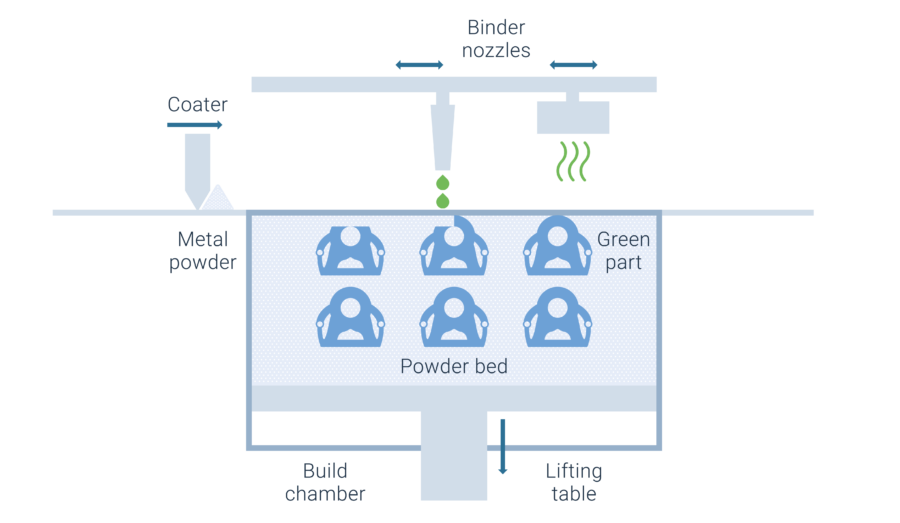AM Process Overview
AM process overview
Which Additive Manufacturing processes exist?
Understanding the different technologies is arguably one of the most important skills to master when starting to work with Additive Manufacturing. However, this has become increasingly difficult in the past few years: Almost every week, a new industrial AM machine OEM is emerging on the market. This section will provide an overview of different technologies as well as the overall AM workflow.
What you will find in this section
Technologies by feedstock type
Metal and Polymer AM landscape
Over the last three decades, more and more Additive Manufacturing processes have emerged and there are numerous ways to classify them. One common way is to classify processes by baseline technology, e.g. laser-based processes or extrusion processes etc.
Another common classification is by feedstock type, i.e. powder, filament or wire. The following maps provides a good overview of the different polymer and metal processes divided by feedstock type. These maps will be further discussed in the online learning courses on metal and polymer technologies. We highlighted some of the most common processes in the circles.
Metal Additive Manufacturing Process Landscape
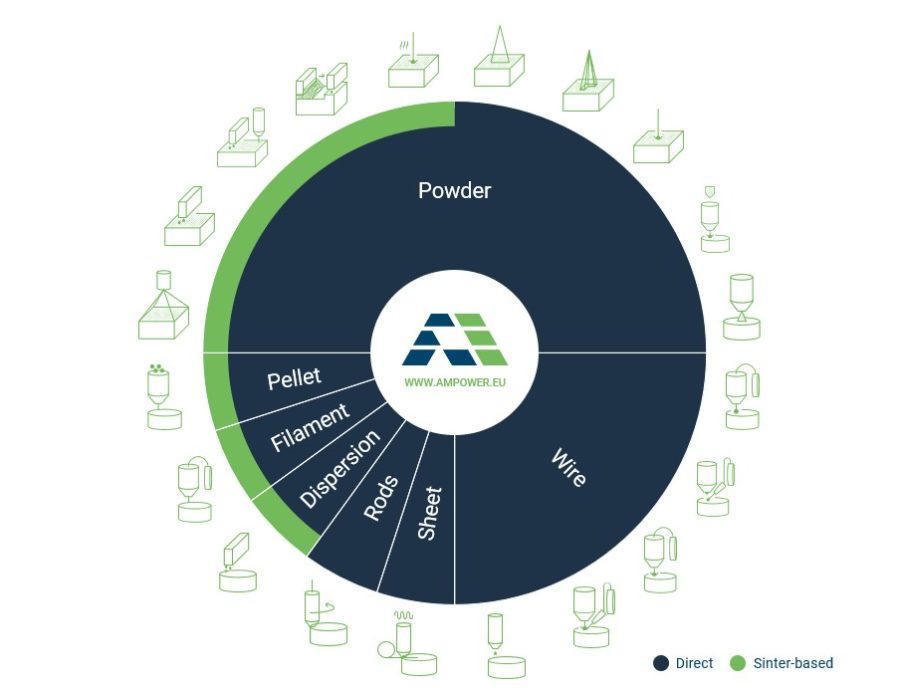
Electron Powder Bed Fusion
Laser Powder Bed Fusion
Powder Laser Deposition
Coldspray
Wire Arc Deposition
Metal Material Extrusion
Binder Jetting
Polymer Additive Manufacturing Process Landscape
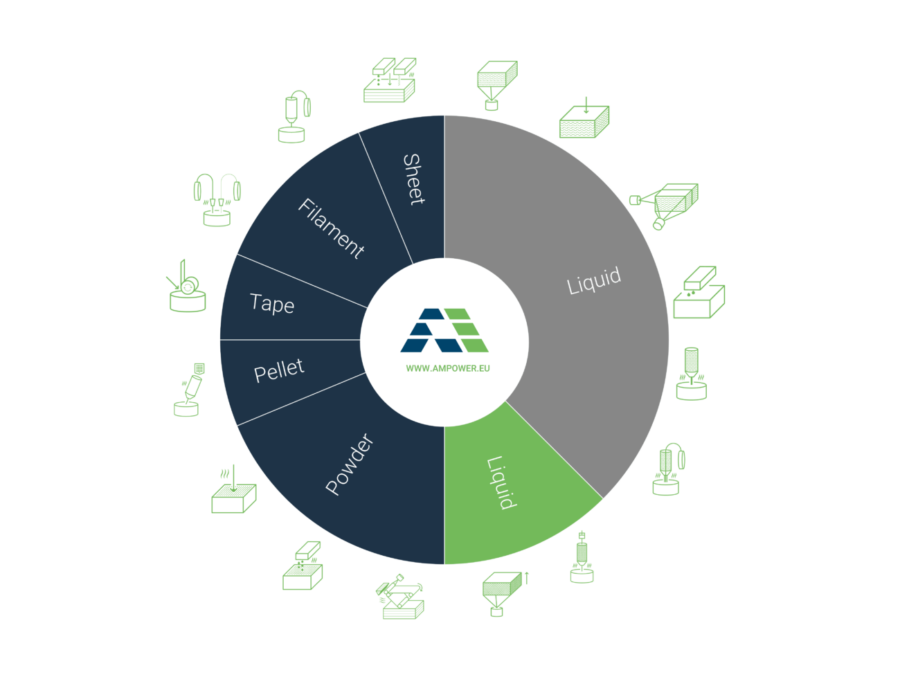
Vat Polymerization
Material Jetting
Powder Bed Fusion
Pellet Material Extrusion
Filament Material Extrusion
Process categories
The 7 official process categories
A further way to classify technologies today is by 7 main categories defined by ISO and ASTM in the standard 52900-15. We will briefly give an overview of the 7 categories including process description, material categories, typical applications and AM process variants, followed by videos of some of the most common AM processes below.
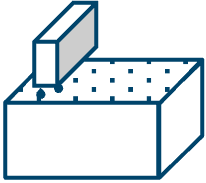
Process description:
A liquid bonding agent is selectively deposited to join powder materials.
Materials:
Metal and sand
Typical applications:
- Serial metal parts ≈500-20.000
- Printing of sand molds
AM process variants – a selected overview
- Binder Jetting (BJT)
- Multi Jet Fusion© (MJF)
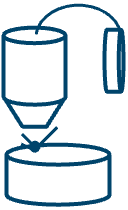
Process description:
A focused energy source used to fuse materials as they are being deposited.
Materials:
Metal
Typical applications:
- Repair/coating of shafts for oil & gas/heavy duty machinery
- Aviation Ti parts
AM process variants – a selected overview
- Laser Engineering Net Shape (LENS)
- Electron Beam Additive Manufacturing (EBAM)
- Rapid Plasma Deposition
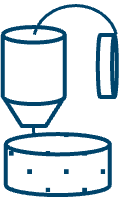
Process description:
Material is selectively dispensed through a nozzle or orifice.
Materials:
Metal, polymer and composite
Typical applications:
- 3D printing @ home
- High performance polymers (e.g. PEEK)
AM process variants – a selected overview
- Fused Deposition Modeling (FDM) – Polymer
- Arburg Plastic Freeforming (APF) – Polymer

Process description:
Droplets of build material are selectively deposited.
Materials:
Metal, polymer and wax
Typical applications:
- Multicolor/-mate-rial prototypes
- Wax patterns for jewelry
- Molds for investmment casting
AM process variants – a selected overview
- Material Jetting (MJ) – Polymer
- Multi-Jet Modeling (MJM) (also: MultiJet Printing (MJP), PolyJet) – Polymer
- NanoParticle Jetting (NPJ) – Polymer
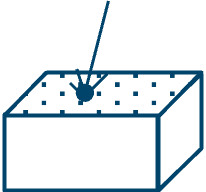
Process description:
Energy source selectively fuses regions of a powder bed.
Materials:
Metal and polymer
Typical applications:
- Polyamer prototypes
- Complex metal parts: Implants, fuel nozzle, turbine blades
AM process variants – a selected overview
- Laser-beam PBF of polymers (L-PBF) (also: Selective Laser Sintering (SLS)) – Polymer
- LB-PBF of metals (L-PBF) (also: Direct Metal Laser Sintering (DMLS), Selective Laser Melting (SLM), Laser Metal Fusion (LMF)) – Metal
- Electron beam PBF of metals (E-PBF) (also: Electron Beam Melting (EBM)) – Metal
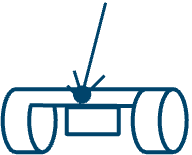
Process description:
Sheets of material are bonded to form a part.
Materials:
Composite, paper
Typical applications:
Full color paper prototypes
AM process variants – a selected overview
- Laminated Object Manufacturing
(LOM) – Other

Process description:
Liquid photopolymer in a vat is selectively cured by light-activated polymerization.
Materials:
Ceramic, photopolymer
Typical applications:
- Silicone hearing aids
- High surface finish prototypes
AM process variants – a selected overview
- Stereolithography (SLA) – Polymer
- Digital Light Processing (DLP) – Polymer
- Continuous Digital Light Processing (CLIP) – Polymer
- Lithography-based Ceramic – Ceramic Manufacturing (LCM) – Ceramic
The AM workflow
From virtual file to final part
The process of producing a part works in very different ways depending on the technology and the most important processes will be explained in more detail later in this course.
The overall process chain, covering the steps from a digital file to a finished product, is generally shared by all processes. There will, however, be some variations depending on the process and certain steps will require more effort whereas other steps will be more trivial for some processes.
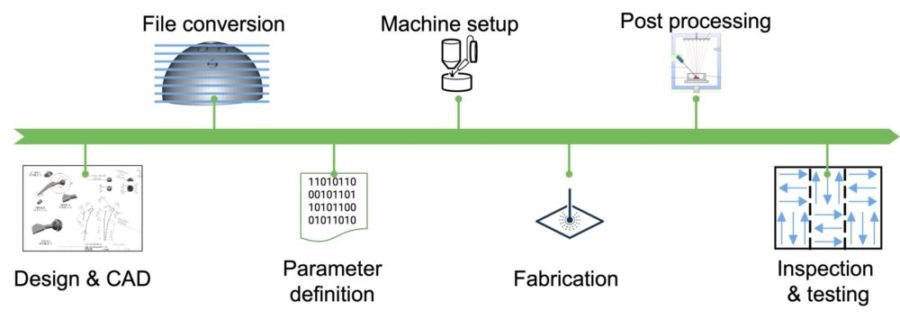
While a lot of of focus is usually put on the actual fabrication of the part, it often only accounts for a small portion of the overall process. It is thus important to be aware of all the different steps. We will give a quick overview of the different steps here.
Computer Aided Design
Every AM process starts with 3D CAD information of the part to be produced.
Read MoreStep 1File Conversion
Once the CAD file has been finalized, it must be converted - usually into an STL file.
Read MoreStep 2Parameter Definition
Before starting the print job, machine-specific parameters need to be assigned.
Read MoreStep 3
Machine Setup
Once the print file has been sent to the printer, the machine needs to be set up physically.
Read MoreStep 4Post Processing
Post processing refers to the often manual operations that are required after a print to finish a part for its application purpose.
Read MoreStep 6Quality Control & Testing
The final step is the quality control and testing of a part.
Read MoreStep 7Videos of selected processes
Additive Manufacturing technologies in action
Below you can find a video explaining the 7 different process categories as well as brief videos of some of the most common Additive Manufacturing processes by hubs. A more detailed explanation of the different processes can be found in the two online learning programs Polymer Technologies and Metal Technologies.

By loading the video, you agree to YouTube's privacy policy.
Learn more
Source: CanalDivulgación

By loading the video, you agree to YouTube's privacy policy.
Learn more

By loading the video, you agree to YouTube's privacy policy.
Learn more
Source: hubs

By loading the video, you agree to YouTube's privacy policy.
Learn more

By loading the video, you agree to YouTube's privacy policy.
Learn more
Source: hubs

By loading the video, you agree to YouTube's privacy policy.
Learn more
Source: Thomáš Vít

By loading the video, you agree to YouTube's privacy policy.
Learn more



